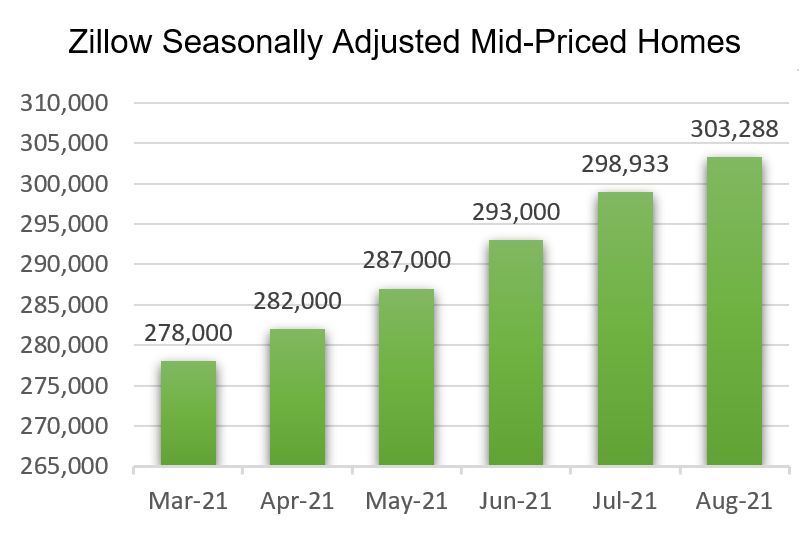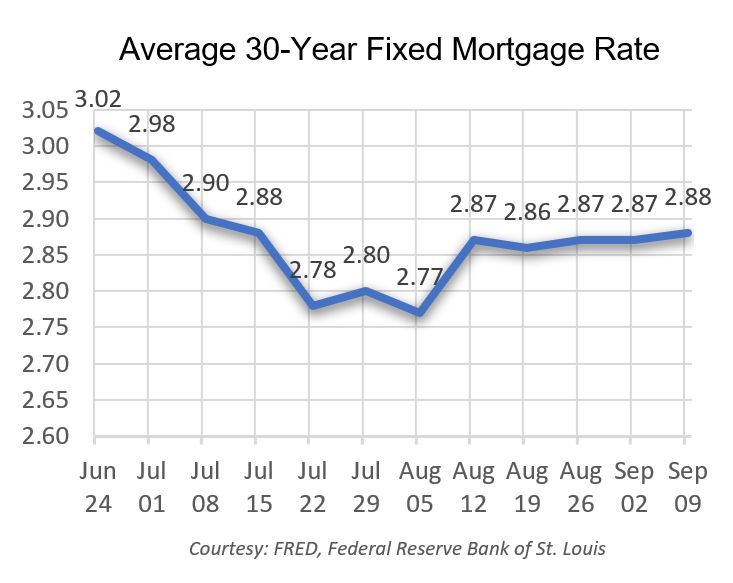National housing market indicators as of August showed housing market activity improving overall. The pandemic has seen one of the tightest housing markets in a long time. Now, after hitting a 40-year low, the housing market is slowly seeing an increase in inventory.
Home prices in the U.S. have climbed at a record pace during the pandemic, with many homes selling above their asking price. The trend continued in August. However, the buyer demand still outpaces the supply; but the growing inventory is giving home shoppers a little breathing room.
Here are the monthly real estate market indicators available at the end of August.
Home Value Index
- The typical U.S. home value in August is now $303,288 (seasonally adjusted value and includes only the middle price tier of homes).
- Values for homes in the U.S. have increased 17.7% over 2020.
- Zillow predicts home prices will rise 12.1% in the next year.

New Home Sales Showed Modest Gains
- July’s new single-family home sales are up in all regions of the country except for the Northeast, where they are level.
- Overall, in July, new single-family home sales increased one percent to 708,000 units (SAAR) from June’s revised pace of 701,000 units. However, this is 27.2% lower than 2020.
- Average sales for the first half of the year are at a seasonally adjusted rate of 818,000, down slightly from the annual pace in 2020 (822,000). (Sources: HUD and Census Bureau).
Existing Home Sales Increased for the Second Consecutive Month
- The National Association of Realtors® (NAR) reports that July sales of existing single-family homes (including townhomes, condominiums, and cooperatives) rose 2.0% to 5.99 million units (SAAR) from the revised pace of 5.87 million for June.
- 1.5% higher than 2020.
- Average sales for the first half of the year, at 6.07 million (SAAR), are higher than the annual pace for 2020 (5.64 million). (Source: NAR).
New Home Construction Declined
Single-Family Housing Starts:
- July saw a decline of 4.5% from June’s upwardly revised pace of 1.16 million units.
- However, July single-family starts were up 11.7% from a year ago.
Multifamily Housing Starts (5+ units):
- Also in July, there was a decrease of 13.6% (412,000 units, SAAR), from an upwardly adjusted 477,000 units in June.
- July’s multifamily housing starts were down 16.3% from last year.
Housing Starts:
- July experienced a decrease of 7.0% to 1.53 million units (SAAR), up 2.5% from 2020.
- Lumber prices, which were high during the pandemic, have been on a downward trend since June. (Sources: HUD and Census Bureau).
House Price Increases Continue to Accelerate
- June’s purchase-only house price index estimated that home values increased 1.63 percent from the previous month and 18.8 percent from the previous year. This is up from an 18.1-percent annual gain in May and the thirteenth straight month that annual house price gains have accelerated.
- The FHFA index shows that U.S. home values are 52% above their peak set in April 2007 during the housing bubble.
- U.S. home values now stand at 93% above the low point reached in May 2011.
In June, the non-seasonally adjusted (NSA) CoreLogic Case- Shiller® 20-City Home Price Index posted a 1.97% increase in home values. The year-over-year returns of 19.1% were up from an annual gain of 17.1% in May, marking the largest gain in more than 30 years of Case-Shiller data.
According to S&P Case-Shiller, “The last several months have been extraordinary not only in the level of price gains but in the consistency of gains across the country.”
Note: The home price data for both indices are based on real estate sales contracts signed in late April and throughout May, with subsequent closings during June. (The FHFA and CoreLogic Case-Shiller® price indices are released with a 2-month lag.)
Homes For Sale Inventory Increased
- The listed inventory of new homes for sale was 367,000 units at the end of July, which was up 5.5% from June and 26.1% year-over-year.
- That inventory would support 6.2 months of sales at the current sales pace, up from 6.0 months in June.
- Available existing homes for sale in July were 1.32 million, up 7.3% from June but down 12.0% from the 1.50 million units available a year earlier.
Forbearance on Mortgage Loans Remained the Same Week-Over-Week
- The share of mortgage loans in forbearance was 3.25% the week ending August 22.
- Down from 7.20% in 2020.
- The forbearance rate reached a high of 8.55% the week ending June 7, 2020.
- The Mortgage Bankers Association (MBA) estimates that 1.62 million homeowners are currently in forbearance plans.
The 30-Year-Fixed-Rate-Mortgage (FRM)
- The 30-year FRM remains below 3.0%.
- The 30-year FRM reached an average weekly low in August of 2.77% the week ending August 5.
- The record weekly low-interest rate is 2.65% the week ending January 7, 2021.
- Prior to March 2020, the record low for the 30-year FRM was 3.31% the week ending November 21, 2012, during the recovery from the Great Recession.
 Housing Insecurity Due to the Pandemic Remains Elevated
Housing Insecurity Due to the Pandemic Remains Elevated
- The most recent HUD data (8/4/21 to 8/16/21) shows that approximately 15.4% or 6.88 million U.S. renter households are behind on their rent.
- On average, renter households are 2.3 months behind on their payments.
- 10.8% of renters are six or more months behind on their payments.
- HUD estimates that 6.8%, or 5.40 million, U.S. homeowner households are behind on their mortgage payments.
- 18.4% (1.46 million) homeowners fear they are two months away from foreclosure.

